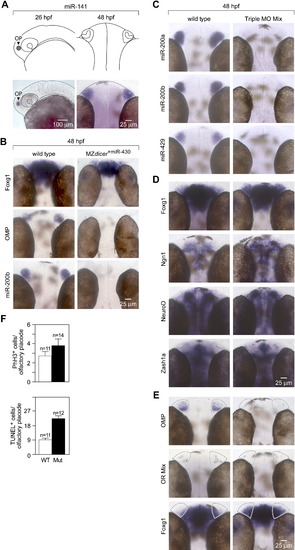- Title
-
Members of the miRNA-200 Family Regulate Olfactory Neurogenesis
- Authors
- Choi, P.S., Zakhary, L., Choi, W.Y., Caron, S., Alvarez-Saavedra, E., Miska, E.A., McManus, M., Harfe, B., Giraldez, A.J., Horvitz, R.H., Schier, A.F., and Dulac, C.
- Source
- Full text @ Neuron
|
Zebrafish miR-200 Family Members Are Required for Terminal Differentiation of Olfactory Progenitor Cells (A) Schematic diagram of the zebrafish olfactory placode and olfactory organ at 26 hpf and 48 hpf, respectively, and corresponding expression pattern of miR-141, a member of the miR-200 family. (B) MZdicer embryos were injected with miR-430 (MZdicer+miR-430) to substantially rescue general neuronal and other phenotypic defects observed in MZdicer mutants by supplying the critical miRNA expressed during the earliest stages of development (Giraldez et al., 2005). MZdicer+miR-430 embryos assayed for expression of olfactory progenitor (foxg1), mature neuron (OMP), and miRNA (miR-200b) markers show impaired terminal differentiation of olfactory progenitors. (C) In situ hybridization staining of 48 hpf embryos for expression of miR-200a, miR-200b, and miR-420 that were injected at the one-cell stage with a combination of miR-141 MO, miR-200b MO, and miR-429 MO (4 ng each; Triple MO Mix) show complete loss of miR-200 family expression. (D) Wild-type and fish injected with various morpholinos at 48 hpf are morphologically indistinguishable from each other with the exception of expanded Foxg1 expression (see panel [E]). (E) Triple MO morphants injected at the one-cell stage and assayed for expression of olfactory progenitor marker (foxg1) and mature neuronal markers (OMP and an olfactory receptor mix) at 48 hpf show impaired terminal differentiation of olfactory progenitors. (F) Quantification of phospho-histone H3 immunoreactive cells (mean ± SEM, WT 2.55 ± 0.45, n = 11; morphant 3.57 ± 0.67, n = 14, p = 0.24, Student′s t test) and TUNEL immunoreactive cells (mean ± SEM, WT 12.55 ± 1.46, n = 11; mutant 30.67 ± 2.59, n = 12, p < 0.01, Student′s t test) in 72 hpf Triple MO morphant olfactory epithelia and controls reveals a statistically significant difference in apoptosis, but not proliferation. |
|
Anti-Sense Morpholino Oligos Specifically and Efficiently Knock Down Expression of Their Cognate Zebrafish miR-200 Targets EXPRESSION / LABELING:
|


